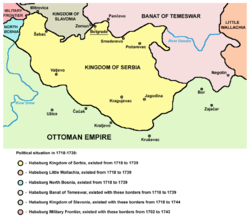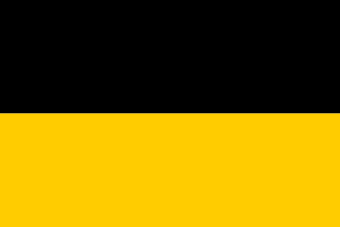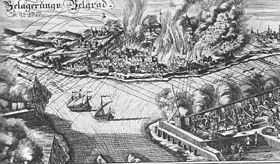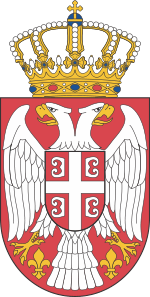Kingdom of Serbia (1718–39)
| Kingdom of Serbia | |||||
| Königreich Serbien | |||||
| Crownland of the Habsburg Monarchy | |||||
| |||||
 Kingdom of Serbia (1718–39) | |||||
| Capital | Belgrade | ||||
| Languages | Serbian, German | ||||
| Religion | Roman Catholic, Serbian Orthodox | ||||
| Government | Crownland | ||||
| Governor | |||||
| - | 1718–1720 | Johann O'Dwyer | |||
| - | 1738–1739 | George de Wallis | |||
| Historical era | Early modern period | ||||
| - | Treaty of Passarowitz | 21 July 1718 | |||
| - | Austro-Turkish War | 1737–39 | |||
| - | Treaty of Belgrade | 18 September 1739 | |||
| Currency | Kreuzer | ||||
The Kingdom of Serbia (Serbian: Краљевина Србија/Kraljevina Srbija; German: Königreich Serbien; Latin: Regnum Serviae) was a province (crownland) of the Habsburg monarchy from 1718 to 1739. It was formed from the territories to the south of the rivers Sava and Danube, corresponding to the paşalık of Belgrade, conquered by the Habsburgs from the Ottoman Empire in 1717. It was abolished and returned to the Ottoman Empire in 1739.
Although Habsburg rule was more oppressive than Ottoman and exploited the local Serb majority, the latter did benefit from self-government, including an autonomous militia, and economic integration with the Habsburg monarchy—reforms that contributed to the growth of the Serb middle class and were continued by the Ottomans "in the interest of law and order".[1] Serbia's population increased rapidly from 270,000 to 400,000, but the decline of Habsburg power in the region provoked the second Great Serb Migration (1737–39).
History
In the 17th century, entire territory of present-day Serbia was under Ottoman administration. In 1688–89, during the Great Turkish War, the Habsburg troops temporarily took control over most of present-day Serbia, but were subsequently forced into retreat. The Treaty of Karlowitz of 1699 recognized Ottoman authority over most of present-day Serbia, while the region of Bačka and the western part of Syrmia were assigned to the Habsburgs.
After the gains of 1718, the Habsburgs sought to integrate Serbia into their empire. The land was officially named the "Kingdom of Serbia", because it was neither a part of the Holy Roman Empire nor the Kingdom of Hungary. The actual administration of the province was in the hands of an appointed governor. Not all the Serb-inhabited territory conquered by the Habsburgs in 1718 was included into Kingdom of Serbia. A large eastern province was administratively separate as the Banat of Temeswar.
After a new Austro-Turkish War (1737–39), the Habsburg monarchy lost all territories south of the Sava and Danube rivers, including the whole territory of the Kingdom of Serbia, it retained, however, the Banat of Temeswar. The end of Habsburg rule resulted in the second Great Serb Migration (1737–39).
Government
Serbia was jointly supervised by the Aulic War Council and the Court Chamber, and subordinated to a local military-cameral administration.[2]
- Governors
- Johann Joseph Anton O'Dwyer (1718–1720) (known as "General Odijer")
- Charles Alexander, Duke of Württemberg (1720–1733)
- Karl Christoph von Schmettau (1733–1738)
- George Oliver de Wallis (1738–1739)
Demographics
A 1720 regulation declared that Belgrade was to be settled mainly by German Catholics, while the Serbs were to live outside the city walls in the "Rascian" part.[2] It has been estimated that the population in the 1720s did not exceed 20,000.[2] The population increased rapidly from 270,000 to 400,000, but the end of Habsburg power in the region resulted in the second Great Serb Migration (1737–39).
Aftermath
Although the Habsburg administration over this part of present-day Serbia was short-lived, the consciousness about separate political entity was left behind by the Habsburgs, thus local inhabitants never again fully accepted Ottoman administration, which lead to Koča's frontier rebellion in 1788 and to the First Serbian Uprising in 1804, which ended direct Ottoman rule over this part of present-day Serbia.
| Wikimedia Commons has media related to Kingdom of Serbia (1718–1739). |
References
Sources
- Joseph Langer (1889). "Serbien unter der kaiserlichen Regierung : 1717 - 1739". Mittheilungen des k.k. Kriegsarchivs, Wien, Bd. III.
- Theodor von Stefanović-Vilovsky (1908). Belgrad unter der Regierung Kaiser Karls VI: (1717-1739) mit Benützung Archivalischer und Anderer Quellen. Holzhausen.
- Olga Zirojević, Srbija pod turskom vlašću 1459-1804, Beograd, 2007.
- Vladimir Ćorović, Ilustrovana istorija Srba, knjiga četvrta, Beograd, 2006.
- Dušan J. Popović, Beograd pre 200 godina, Beograd, 1935. (republished as "Beograd u XVIII veku, od 1717. do 1739.", Beograd, 2011.)


